
The 2009 FEI Alltech European Show Jumping and Dressage Championships at Windsor (August 25-30) are a landmark for Martin Collins, inventor and installer of Windsor’s three Ecotrack arenas. This is the first time a FEI show jumping championship has been staged in the UK on an outdoor synthetic surface instead of grass.
For over two decades, leading riders and event organisers have chosen Martin’s surfaces for their durability – many arenas installed 10 years ago still don’t need a top-up and have saved many a show in wet conditions. But the purpose of surfaces is not just about outwitting the weather.
Throughout his 30-year career, Collins has striven to replicate the performance of good-going Turf, and Ecotrack is a mixture of synthetic fibres and silica sand with a wax coating, designed to enhance energy-return. Does it make a difference? Robert Whitaker thinks so: "Even with big fences, the horses find more ‘jump’ on Ecotrack - it's true!” he says.
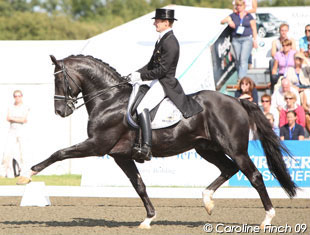 The 2003 European dressage championships at Hickstead took place on Ecotrack’s sister surface, Polytrack (and this arena hosted another headline-grabbing occasion last month when Edward Gal and Moorlands Totilas achieved the highest mark ever awarded for a Grand Prix freestyle to music). Martin Collins surfaces have long been used at Olympia, Hickstead, Stoneleigh, Addington Manor and many competition sites abroad, being specially exported for the Al Maktoum Challenge – then the world’s richest jumping show - in Dubai in 2005.
The 2003 European dressage championships at Hickstead took place on Ecotrack’s sister surface, Polytrack (and this arena hosted another headline-grabbing occasion last month when Edward Gal and Moorlands Totilas achieved the highest mark ever awarded for a Grand Prix freestyle to music). Martin Collins surfaces have long been used at Olympia, Hickstead, Stoneleigh, Addington Manor and many competition sites abroad, being specially exported for the Al Maktoum Challenge – then the world’s richest jumping show - in Dubai in 2005.
Windsor installed its first Ecotrack four years ago when the annual Royal Windsor Horse Show relocated nearer the Castle. Windsor commissioned Martin Collins to extend his existing warm-up ring and install a second, 5,440 m² Ecotrack arena for 2009. All three will be used to the full during the European championships when 180 horses are based on site.
Glynnie Walford, MCE’s managing director, has worked for the company for 18 years and says all their surfaces are designed with the mutually beneficial aspects of performance and welfare in mind.
"Ecotrack produces controlled energy-return, which relates to the surface's cushioning effect and the way it reduces concussion to a horse's limbs," she says. "When a horse is jumping, Ecotrack allows the correct amount of ‘sheer’ and joint rotation on landing, and also provides stability on take-off.
"It is important for riders to maintain the long-term health of their competition horses' limbs and joints as they age, which is why Ecotrack is used extensively across all equestrian disciplines."
European dressage bronze and silver medallist Emile Faurie has trained his own horses on Martin Collins surfaces for 12 years. He said: “Movement in dressage horses is becoming bigger and bigger. Young horses need to learn to move to the maximum of their ability and to develop muscles correctly, and to develop confidence from day one. If they lose that confidence, it’s almost impossible to get it back. When the surface is unforgiving, it is any surprise when the horse thinks ‘I don’t want to do this anymore?’ The wrong surface can cost you a medal.”
British team member Ben Maher offers the show jumper’s different perspective: “Many surfaces abroad lack the bounce and stability of a Martin Collins surface, and without that, you can often undermine a horse’s confidence. Show jumpers would describe a ‘dead’ surface as one when you don’t get a push off the floor. On Ecotrack you can place a horse better, the ground is level, they get the same feeling over a jump and the horse can do a better job.”
During the European championships the Ecotrack will be worked throughout using specialist machinery to fulfil the different going requirements of show jumping (tighter) and dressage (more cut).
Simon Brooks-Ward, Windsor’s show director, said: “In April this year, our preparations for the Alltech FEI European Jumping and Dressage Championships meant we needed an additional arena, as well as extend our current collecting ring, in order to compete with the world’s best venues.
“Of course we reviewed the options, but chose Martin Collins’ Ecotrack surface once again to fulfil our needs. The new arenas were finished only a few weeks ahead of this year’s Royal Windsor and despite the appalling weather we had at times, the surface upheld brilliantly, as it always has.”
Racing connections, and the evolution of Ecotrack
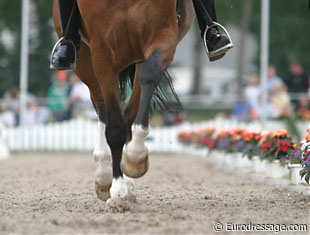 Martin Collins believes that wax-coated surfaces provide superior stability and the correct amount of “give” for the downward and forward movement of the horse’s leg on contact with the ground – an area in which his understanding has been enriched by his parallel innovations in horseracing. Using Polytrack, Collins has surfaced five or the six all-weather racecourses in the UK and Ireland, servicing 30% of racing fixtures. He has surfaced 14 licensed racecourses in four continents, and 80 miles of training gallops. Polytrack is the only artificial surface to have attracted an entry from the world’s top-rated Turf horse of 2008, the Aidan O’Brien-trained Duke of Marmalade.
Martin Collins believes that wax-coated surfaces provide superior stability and the correct amount of “give” for the downward and forward movement of the horse’s leg on contact with the ground – an area in which his understanding has been enriched by his parallel innovations in horseracing. Using Polytrack, Collins has surfaced five or the six all-weather racecourses in the UK and Ireland, servicing 30% of racing fixtures. He has surfaced 14 licensed racecourses in four continents, and 80 miles of training gallops. Polytrack is the only artificial surface to have attracted an entry from the world’s top-rated Turf horse of 2008, the Aidan O’Brien-trained Duke of Marmalade.
The British Horseracing Authority has a strict approvals system for its recognised suppliers. Surfaces must pass tests for toxicity, resilience (the proportion of energy return to the hoof; too much makes the surface springy, too little makes it “dead”), depth (hoof penetration), footing (further compaction after the peak force is recorded); hardness (the maximum force experienced by the test hoof); surface stiffness (the initial rate of deflection of the surface); “harmonic stiffness” (the contact time of the test hoof with the ground); shock absorption (to minimise jarring); and cohesion (to minimise kickback). The surface must retain all these properties from -10 to +40 deg C. Field trials of six to nine months, and trainer, jockey, medic and veterinary feedback, finalise the decision.
The equestrian industry has no equivalent tests, so this means that, unlike some competitors, Polytrack has been through rigorous independent testing, and this in turn benefits the whole range of Martin Collins products.
Polytrack is easy to maintain, making it suitable for everything from dressage to winter Flat racing. Because equestrian sport now emphasises warmblood rather than Thoroughbred influences, Collins has recognised the subtle differences in the muscular and skeletal make-up of the respective horse types. Ecotrack, a variation on the Polytrack recipe, was developed for professional equestrians, and within the brand the mixture varies depending on the principal use.
Extensive research into surfaces has been undertaken in recent years by Dr Rachel Murray, Head of the Centre for Equine Studies at the Animal Health Trust, Newmarket and an acknowledged world authority on lameness in the sport horse. This suggests that wax-coated surfaces, of which Polytrack and Ecotrack are the pioneers, can reduce the risk of lameness compared with sand, sand and PVC granules mixes, woodchip or less than perfect Turf.
What show jumpers think about Windsor’s Ecotrack:
Robert Whitaker: "It's great; all horses jump really well on it. Even with the big fences the horses find more jump on this surface. It's true!"
Shane Breen: “The Ecotrack is very good, and gives horses a lot of confidence when they jump, because it has such a nice cushion. The ground never moves under them and is consistently reliable.”
Ben Maher: “The Ecotrack at Windsor is second to none and will be a real showcase for British show jumping during the Europeans. Many surfaces abroad lack the bounce and stability of a Martin Collins surface which can often undermine a horses' confidence. His surfaces always offer reliability underfoot. It is a secure yet forgiving surface for professional show jumping. Show jumpers would describe a ‘dead’ surface as one when you don’t get a push off the floor. On synthetic surfaces you can place a horse better, the ground is level, they get the same feeling over a jump and the horse can do a better job.”
Michael Whitaker: “Ecotrack provides the right amount of ‘give’ and a very stable grip so that horses feel secure on take-off and landing. The surface is so important in keeping top class show jumpers sound and there is no doubt that training at home and competing internationally on these surfaces helps to reduce the risk of injury. They are consistent, easy to look after, dust free and stand up to any amount of work and weather conditions - they would always be my first choice.”
Mark Armstrong: “We’re lucky to have this surface to jump on – Windsor is a show to be proud of. I’d rather be here than in La Baule [the Nations Cup meeting in France which often clashes with Royal Windsor]. ”
General comments about Martin Collins surfaces
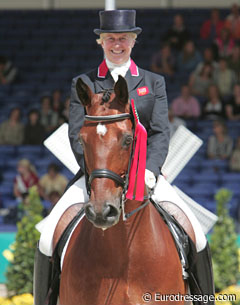 Jane Gregory, dressage rider: “Lucky Star, my Olympic horse, has been trained on a Martin Collins surface since he was four. At 17 he is at the top of his profession and testament to the consistency of Martin’s surfaces.”
Jane Gregory, dressage rider: “Lucky Star, my Olympic horse, has been trained on a Martin Collins surface since he was four. At 17 he is at the top of his profession and testament to the consistency of Martin’s surfaces.”
Captain Mark Phillips: “Without doubt Martin Collins produces the best synthetic surfaces in the world. My Martin Collins surfaces at home have been down for 10 years. We have never lost a day's training on them and the surfaces are as good today as the day they were installed.”
Edward Bunn, Director, All England Jumping Course, Hickstead: “Having run two seasons of show jumping, and one season of arena polo on our Ecotrack outdoor arena, we now know that we made the right choice. Playing on such as surface is so kind to polo ponies' legs that they need a shorter holiday before the summer season and old horses can compete for longer."
Emile Faurie, dressage rider: “Both my Martin Collins surfaces have been down for 12 years and I have not experienced any problems. The horses perform confidently because they have a more secure footing that absorbs impact. Movement in dressage horses is becoming bigger and bigger. “As young horses, they need to learn to move to the maximum of their ability and to develop muscles correctly, and to develop confidence from day one. If they lose that confidence, it’s almost impossible to get it back. When the surface is unforgiving, it is any surprise when the horse thinks ‘I don’t want to do this anymore?’ The wrong surface can cost you a medal.”
Clayton Fredericks, three-day event rider: “Having installed our Ecotrack lunge surface we have been impressed by the security and confidence it gives our horses. We have also added Clopf fibre to our arena and have been delighted with the improvement in stability and spring. Both Lucinda and I firmly believe that the surfaces have contributed to our success."
Comments from Horse Racing Professionals
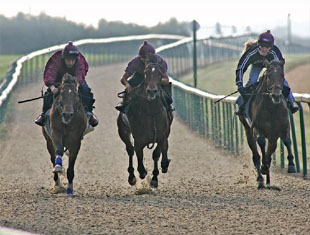 Paul Nicholls, champion National Hunt trainer:“Ecotrack is now installed on both my flat and uphill gallops and my loose jumping arena. We are really pleased with the performance of all three facilities. The surface is safe, consistent and has been a great investment.”
Paul Nicholls, champion National Hunt trainer:“Ecotrack is now installed on both my flat and uphill gallops and my loose jumping arena. We are really pleased with the performance of all three facilities. The surface is safe, consistent and has been a great investment.”
William Gittus, Managing Director, Jockey Club Estates:"The relationship between Martin and JCE has existed for the last 15 years. The training grounds in the UK are used by over 3,000 horses daily. The MCE surfaces that we use on 21 different sites are of excellent quality and durability. We cannot give a better recommendation other than the fact that our relationship with MCE has lasted so long and that so many of our tracks are surfaced with MCE materials."
Sooing Tze Ming, Singapore Jockey Club: “No stones were left unturned in our selection process for the new racetrack. We have monitored the synthetic surfaces on factors such as injury rates, infiltration rates, surface hardness and surface temperatures to arrive at our decision. Polytrack proved to have the edge.”
Jeremy Noseda, Newmarket trainer: "The Polytrack gallops that we use in Newmarket offer a fantastic surface to work on. The horses enjoy working on it, stay sound and I firmly believe that is the best artificial surface in the world."
Ian Renton, Racing Director, Arena Leisure plc: "We have Polytrack at Lingfield and Wolverhampton. Trainers note that Polytrack is a safe surface, and that it rides like turf. It has increased the welfare element no end by reducing the jarring effect which means that there have been less injuries."
Ian Wright, Partner, Greenwood Ellis & Partners veterinary surgeons, Newmarket: “Having the best surfaces available for lameness evaluation was a priority for the Hospital. This was researched extensively before Martin Collins’ Ecotrack surface was selected”.
Oliver Sherwood, Lambourn trainer: “The recent improvements to the Mandown Gallops are fantastic. The Back of the Hill gallop used to be woodchip, but is now surfaced with a Martin Collins material. The difference in consistency is remarkable and we know exactly what ride to expect, which is essential. The installation is invaluable; a point which has been proved by the success of the Lambourn trainers in recent seasons.”
About Martin Collins
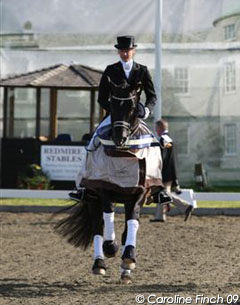 Last year Martin’s contribution to riding surfaces was recognised with the Royal Warrant of Appointment by Her Majesty the Queen.
Last year Martin’s contribution to riding surfaces was recognised with the Royal Warrant of Appointment by Her Majesty the Queen.
It is nearly 30 years since Martin began developing innovative, synthetic surfaces, pooling his experiences in equestrianism and construction. He began his career as a working pupil with Alison and Alan Oliver, gaining permission to ride in adult BSJA show jumping classes aged 15. He later worked in yard maintenance for the legendary Dick Stilwell, the former BSJA National Coach, and trained his own grade A jumpers. To subsidise his riding, Martin undertook underpinning and technical building work for Windsor Safari Park and Berni Inns. He decided to invent a sand-based riding surface that was not merely “all-weather” but mimicked the properties of turf, so that each imprint left by the horse would spring back.
In 1996, he opened a purpose-built factory at Lambourn, Berks. This allows all products to be mixed under cover to ensure consistency and quality control. A new manufacturing plant opened in the summer of 2009 in the North-West. Major investments in to overseas plant, research and development continue, and products undergo stringent environmental testing.
Nowadays, Collins favours wax-coated surfaces – Polytrack (racing), Ecotrack and Activ-Track. He also produces Clopf, a cost-effective fibre additive which can enhance an existing silica sand or sand/PVC granule mixture surface. Although it was pitched at the amateur market it has been used at the leading continental venues of Verden in Germany and Valkenswaard, where the Dutch leg of the Global Champions Tour takes place, and to upgrade Mijas racecourse in Spain.
Martin Collins has a plant at Keeneland racecourse in Kentucky. The American division, Martin Collins Surfaces and Footings LLC (MCSF), will have a major presence during the World Equestrian Games next year when “Polytrack Park” is a feature of the concurrent 2010 International Equestrian Festival™ from September 25 – October 10, 2010, at Lexington Convention Centre.
Martin has a variety of personal horse interests. He has had a number of Flat and National Hunt horses in training and as a member of Royal Ascot Racing Club he has the distinction of part-owning the 2005 Epsom Derby winner, Motivator!
Official website: Martin Collins Ltd.
Back to the 2009 European Dressage Championship index